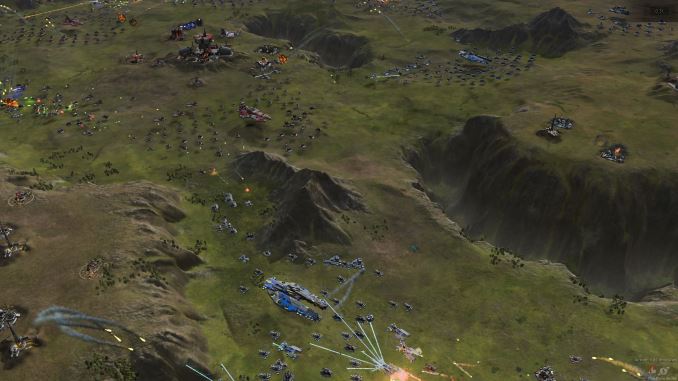GeForce + Radeon: Previewing DirectX 12 Multi-Adapter with Ashes of the Singularity
by Ryan Smith on October 26, 2015 10:00 AM ESTFirst Thoughts
Wrapping up our first look at Ashes of the Singularity and DirectX 12 Explicit Multi-Adapter, when Microsoft first unveiled the technology back at BUILD 2015, I figured it would only be a matter of time until someone put together a game utilizing the technology. After all, Epic and Square already had their tech demos up and running. However with the DirectX 12 ecosystem still coming together here in the final months of 2015 – and that goes for games as well as drivers – I wasn’t expecting something quite this soon.
As it stands the Ashes of the Singularity multi-GPU tech demo is just that, a tech demo for a game that itself is only in Alpha testing. There are still optimizations to be made and numerous bugs to be squashed. But despite all of that, seeing AMD and NVIDIA video cards working together to render a game is damn impressive.
Seeing as this build of Ashes is a tech demo, I’m hesitant to read too much into the precise benchmark numbers we’re seeing. That said, the fact that the fastest multi-GPU setup was a mixed AMD/NVIDIA GPU setup was something I wasn’t expecting and definitely makes it all the more interesting. DirectX 11 games are going to be around for a while longer yet, so we’re likely still some time away from a mixed GPU gaming setup being truly viable, but it will be interesting to see just what Oxide and other developers can pull off with explicit multi-adapter as they become more familiar with the technology and implement more advanced rendering modes.
Meanwhile it’s interesting to note just how far the industry as a whole has come since 2005 or even 2010. GPU architectures have become increasingly similar and tighter API standards have greatly curtailed the number of implementation differences that would prevent interoperability. And with Explicit Multi-Adapter, Microsoft and the GPU vendors have laid down a solid path for allowing game developers to finally tap the performance of multiple GPUs in a system, both integrated and discrete.
The timing couldn’t be any better either. As integrated GPUs have consumed the low-end GPU market and both CPU vendors devote more die space than ever to their respective integrated GPUs, using a discrete GPU leaves an increasingly large amount of silicon unused in the modern gaming system. Explicit multi-adapter in turn isn’t the silver bullet to that problem, but it is a means to finally putting the integrated GPU to good use even when it’s not a system’s primary GPU.
However with that said, it’s important to note that what happens from here is ultimately more in the hands of game developers than hardware developers. Given the nature of the explicit API, it’s now the game developers that have to do most of the legwork on implementing multi-GPU, and I’m left to wonder how many of them are up to the challenge. Hardware developers have an obvious interest in promoting and developing multi-GPU technology in order to sell more GPUs – which is how we got SLI and Crossfire in the first place – but software developers don’t have that same incentive.
Ultimately as gamers all we can do is take a wait-and-see approach to the whole matter. But as DirectX 12 game development ramps up, I am cautiously optimistic that positive experiences like Ashes will help encourage other developers to plan for multi-adapter support as well.











180 Comments
View All Comments
SuperVeloce - Sunday, December 6, 2015 - link
X360 and PS3 were already much more "to the metal" than we were used to from DX9. In this respect those consoles have more in common with DX12 than any older DX versionsCreig - Tuesday, October 27, 2015 - link
How long before Nvidia sabotages this the way they stop PhysX from working if an AMD card is detected in your system?0ldman79 - Monday, November 2, 2015 - link
I think Nvidia has already disabled Physx from working if AMD is detected.I couldn't run Physx with my Radeon 5750 and any Geforce card as a Physx co-processor. There was a massive workaround that I got going once for about a half an hour, then I reboot and couldn't get it working again.
I spent around 4 hours of my life trying to get paper to flutter around more realistically in Batman only to have it fail on reboot.
Nvidia really has the wrong idea in this situation. It worked just fine in the past.
Samus - Monday, October 26, 2015 - link
You know...nothing rhymes with orange ;)rituraj - Tuesday, October 27, 2015 - link
flange?AndrewJacksonZA - Tuesday, October 27, 2015 - link
Please suck on a lozenge while rhyming with orange.uglyduckling81 - Sunday, November 1, 2015 - link
Nvidia are not going to like this. They will patch their drivers to make sure this no longer works.lilmoe - Monday, October 26, 2015 - link
What about Intel's iGPU?Ryan Smith - Monday, October 26, 2015 - link
Since this early release is limited to basic AFR, there's little sense in testing an iGPU. It may be able to contribute in the future with another rendering mode, but right now it's not nearly fast enough to be used effectively.DanNeely - Monday, October 26, 2015 - link
What about pairing the IGP with a low end discrete part where the performance gap is much smaller? I'm thinking about the surface book where there's only a 2:1 gap between the two GPUs; but any laptop with a 920-940M part would have a similar potential gain.On the desktop side, AMD's allowed heterogeneous xFire with their IGP and low end discrete cards for a few years. How well that setup works with DX12 would be another interesting test point.